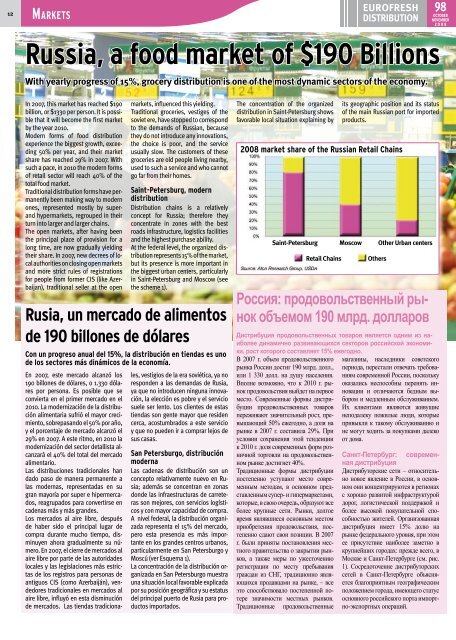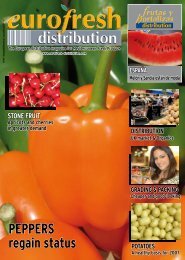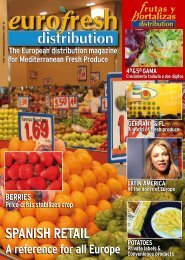produce - Eurofresh Distribution
produce - Eurofresh Distribution
produce - Eurofresh Distribution
You also want an ePaper? Increase the reach of your titles
YUMPU automatically turns print PDFs into web optimized ePapers that Google loves.
12<br />
marketS<br />
EUROFRESH<br />
DISTRIBUTION<br />
Russia, a food market of $190 Billions<br />
With yearly progress of 1 %, grocery distribution is one of the most dynamic sectors of the economy.<br />
In 2007, this market has reached $190<br />
billion, or $1330 per person. It is possible<br />
that it will become the first market<br />
by the year 2010.<br />
Modern forms of food distribution<br />
experience the biggest growth, exceeding<br />
50% per year, and their market<br />
share has reached 29% in 2007. With<br />
such a pace, in 2010 the modern forms<br />
of retail sector will reach 40% of the<br />
total food market.<br />
Traditional distribution forms have permanently<br />
been making way to modern<br />
ones, represented mostly by super-<br />
and hypermarkets, regrouped in their<br />
turn into larger and larger chains.<br />
The open markets, after having been<br />
the principal place of provision for a<br />
long time, are now gradually yielding<br />
their share. In 2007, new decrees of local<br />
authorities on closing open markets<br />
and more strict rules of registrations<br />
for people from former CIS (like Azerbaijan),<br />
traditional seller at the open<br />
En 2007, este mercado alcanzó los<br />
190 billones de dólares, o 1.330 dólares<br />
por persona. Es posible que se<br />
convierta en el primer mercado en el<br />
2010. La modernización de la distribución<br />
alimentaria sufrió el mayor crecimiento,<br />
sobrepasando el 50% por año,<br />
y el porcentaje de mercado alcanzó el<br />
29% en 2007. A este ritmo, en 2010 la<br />
modernización del sector detallista alcanzará<br />
el 40% del total del mercado<br />
alimentario.<br />
Las distribuciones tradicionales han<br />
dado paso de manera permanente a<br />
las modernas, representadas en su<br />
gran mayoría por super e hipermercados,<br />
reagrupados para convertirse en<br />
cadenas más y más grandes.<br />
Los mercados al aire libre, después<br />
de haber sido el principal lugar de<br />
compra durante mucho tiempo, disminuyen<br />
ahora gradualmente su número.<br />
En 2007, el cierre de mercados al<br />
aire libre por parte de las autoridades<br />
locales y las legislaciones más estrictas<br />
de los registros para personas de<br />
antiguos CIS (como Azerbaiján), vendedores<br />
tradicionales en mercados al<br />
aire libre, influyó en esta disminución<br />
de mercados. Las tiendas tradiciona-<br />
markets, influenced this yielding.<br />
Traditional groceries, vestiges of the<br />
soviet ere, have stopped to correspond<br />
to the demands of Russian, because<br />
they do not introduce any innovations,<br />
the choice is poor, and the service<br />
usually slow. The customers of these<br />
groceries are old people living nearby,<br />
used to such a service and who cannot<br />
go far from their homes.<br />
Saint-Petersburg, modern<br />
distribution<br />
<strong>Distribution</strong> chains is a relatively<br />
concept for Russia; therefore they<br />
concentrate in zones with the best<br />
roads infrastructure, logistics facilities<br />
and the highest purchase ability.<br />
At the federal level, the organized distribution<br />
represents 15% of the market,<br />
but its presence is more important in<br />
the biggest urban centers, particularly<br />
in Saint-Petersburg and Moscow (see<br />
the scheme 1).<br />
Rusia, un mercado de alimentos<br />
de 190 billones de dólares<br />
Con un progreso anual del 15%, la distribución en tiendas es uno<br />
de los sectores más dinámicos de la economía.<br />
les, vestigios de la era soviética, ya no<br />
responden a las demandas de Rusia,<br />
ya que no introducen ninguna innovación,<br />
la elección es pobre y el servicio<br />
suele ser lento. Los clientes de estas<br />
tiendas son gente mayor que residen<br />
cerca, acostumbrados a este servicio<br />
y que no pueden ir a comprar lejos de<br />
sus casas.<br />
San Petersburgo, distribución<br />
moderna<br />
Las cadenas de distribución son un<br />
concepto relativamente nuevo en Rusia;<br />
además se concentran en zonas<br />
donde las infraestructuras de carreteras<br />
son mejores, con servicios logísticos<br />
y con mayor capacidad de compra.<br />
A nivel federal, la distribución organizada<br />
representa el 15% del mercado,<br />
pero esta presencia es más importante<br />
en los grandes centros urbanos,<br />
particularmente en San Petersburgo y<br />
Moscú (ver Esquema 1).<br />
La concentración de la distribución organizada<br />
en San Petersburgo muestra<br />
una situación local favorable explicada<br />
por su posición geográfica y su estatus<br />
del principal puerto de Rusia para productos<br />
importados.<br />
The concentration of the organized<br />
distribution in Saint-Petersburg shows<br />
favorable local situation explaining by<br />
Saint-Petersburg Moscow Other Urban centers<br />
В 2007 г. объем продовольственного<br />
рынка России достиг 190 млрд. долл.,<br />
или 1 330 долл. на душу населения.<br />
Вполне возможно, что к 2010 г. рынок<br />
продовольствия выйдет на первое<br />
место. Современные формы дистрибуции<br />
продовольственных товаров<br />
переживают значительный рост, превышающий<br />
50% ежегодно, а доля на<br />
рынке в 2007 г. составила 29%. При<br />
условии сохранения этой тенденции<br />
к 2010 г. доля современных форм розничной<br />
торговли на продовольственном<br />
рынке достигнет 40%.<br />
Традиционные формы дистрибуции<br />
постепенно уступают место современным<br />
методам, в основном представленным<br />
супер- и гипермаркетами,<br />
которые, в свою очередь, образуют все<br />
более крупные сети. Рынки, долгое<br />
время являвшиеся основным местом<br />
приобретения продовольствия, постепенно<br />
сдают свои позиции. В 2007<br />
г. были приняты постановления местного<br />
правительства о закрытии рынков,<br />
а также меры по ужесточению<br />
регистрации по месту пребывания<br />
граждан из СНГ, традиционно являющихся<br />
продавцами на рынке, – все<br />
это способствовало постепенной потере<br />
значимости местных рынков.<br />
Традиционные продовольственные<br />
Retail Chains Others<br />
Россия: продовольственный рынок<br />
объемом 190 млрд. долларов<br />
Дистрибуция продовольственных товаров является одним из наиболее<br />
динамично развивающихся секторов российской экономи-<br />
ки, рост которого составляет 15% ежегодно.<br />
98<br />
OCTOBER<br />
NOVEMBER<br />
2 0 0 8<br />
its geographic position and its status<br />
of the main Russian port for imported<br />
products.<br />
2008 market share of the Russian Retail Chains<br />
магазины, наследники советского<br />
периода, перестали отвечать требованиям<br />
современной России, поскольку<br />
оказались неспособны перенять инновации<br />
и отличаются бедным выбором<br />
и медленным обслуживанием.<br />
Их клиентами являются живущие<br />
неподалеку пожилые люди, которые<br />
привыкли к такому обслуживанию и<br />
не могут ходить за покупками далеко<br />
от дома.<br />
Санкт-Петербург: современная<br />
дистрибуция<br />
Дистрибуторские сети – относительно<br />
новое явление в России, в основном<br />
они концентрируются в регионах<br />
с хорошо развитой инфраструктурой<br />
дорог, логистической поддержкой и<br />
более высокой покупательной способностью<br />
жителей. Организованная<br />
дистрибуция имеет 15% долю на<br />
рынке федерального уровня, при этом<br />
ее присутствие наиболее заметно в<br />
крупнейших городах: прежде всего, в<br />
Москве и Санкт-Петербурге (см. рис.<br />
1). Сосредоточение дистрибуторских<br />
сетей в Санкт-Петербурге объясняется<br />
благоприятным географическим<br />
положением города, имеющего статус<br />
основного российского порта импортно-экспортных<br />
операций.




